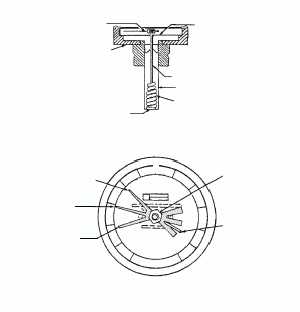Every magazine or locker will have at least one
direct reading thermometer. It will be located where
maximum space temperature variations will normally
occur. It must be installed so it is readily accessible for
taking readings and resetting the index pointers.
Special brackets are available to mount the
thermometer where it can be protected from accidental
damage.
View A of figure 5-5 shows the internal
components of the device. The temperature-sensitive
element is a single helix low-mass coil (bimetal
element) that fits closely inside the thermometer stem.
The bimetal element is carefully sized and aged for
lifetime stability and is covered with a fluid to assure
good heat transfer. The fluid also permits maximum
speed of response and reduces pointer oscillations
caused by outside vibrations. The case and stem are
made from stainless steel for strength and
anticorrosion protection.
View B of figure 5-5 illustrates the dial face of the
thermometer. It is 3 inches in diameter. A plastic
window protects the index pointers. The index reset
arm is on the outside of the window and is used to reset
the high-low pointers. Temperature gradations on our
example are marked off in 20 increments. The
approximate readings on this thermometer are 100 F,
high; 78 F, present; and 55 F, low. After you record
these temperatures, reset the “high” and “low” pointers
in line with the “present” pointer. As temperature rises
during the day, the “present” pointer pushes the “high”
pointer up the scale. As temperature falls during the
night, the “present” pointer reverses direction and
pushes the “low” pointer down the scale. As the sun
comes up, the “present” pointer again moves up the
scale. Thus, we see three different temperature
readings. They reflect the temperature variations
throughout a 24-hour period.
The 45 spread between the high and low pointers
in our example is a bit large. However, it could happen.
The reading you must be cautious about is the 100 F
high. When this occurs, you should turn on the
magazine cooling or ventilation system. If these
systems are not working, you might have to use
artificial cooling (fans, blowers). Topside lockers may
require cooling with water. Remember, the optimum
temperature should be around 70 F.
A magazine temperature record card (fig. 5-6) is
located in each magazine and is posted near the
thermometer for recording daily magazine
temperatures. These cards are replaced on the first day
of each month. The completed cards are removed from
the magazine and the temperatures for each month are
posted in a permanent log. The magazine temperature
cards must be retained on file for a period of one year.
When magazine temperatures are recorded in the
permanent log, temperatures in excess of 100 F must
5-14
POINTER
GAUGE DIAL
POINTER STEM
PROTECTIVE TUBE
BIMETALLIC ELEMENT
MOUNTING
CASE
INDEX RESET
MECHANISM
INDEX
RESET ARM
HIGH TEMPERATURE
INDEX POINTER
PRESENT INDICATING
INDEX POINTER
LOW TEMPERATURE
INDEX POINTER
120
140
20
240
FCf05005
A
B
Figure 5-5.—Bimetallic maximum and minimum thermo-
meter: A. Internal components; B. Dial face and
pointers.
DATE
MAXIMUM
MINIMUM
INITIAL
COMPARTMENT
THERM. Number
MONTH
1
3
2
4
5
6
29
30
31
MAGAZINE TEMPERATURE RECORD
5ND GEN 90 (REV 11-48)
P&PO N or Va 11-2-48 99014 (J c 8) 8M
FCf05006
Figure 5-6.—Magazine Temperature Record Card.





